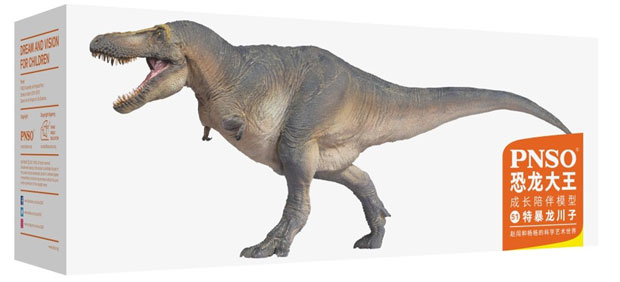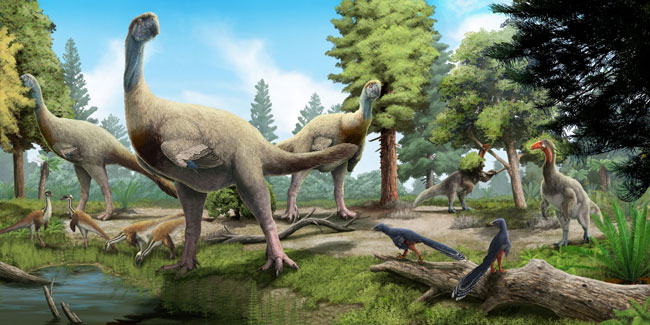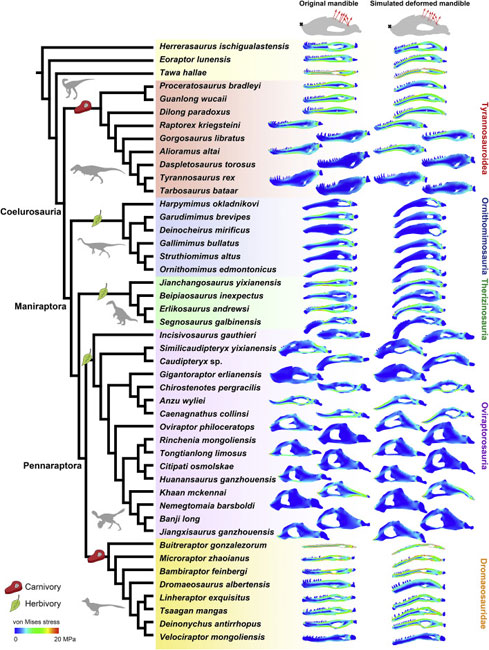Scientists from the University of Birmingham in collaboration with a colleague from University College London have undertaken a detailed study of the lower jaws of theropod dinosaurs. They have concluded that the jaws of these dinosaurs, some of which are very closely related to modern birds, evolved over time to become stronger and more robust.
The study also examined bite stresses imposed on the jaws of Tyrannosaurus rex and Tarbosaurus bataar, looking at the differences in jaw stress between juveniles and adults. This research reveals that mature T. rex and T. bataar have lower jaws that are much more stress resistant than the jaws of juveniles. Adult tyrannosaurs also had a faster bite.

The product packaging for the new PNSO Tarbosaurus dinosaur replica. A typical model of this Late Cretaceous tyrannosaur.
The picture (above) shows the packaging for the PNSO Tarbosaurus figure.
To view the PNSO range of models and figures: PNSO Age of Dinosaurs Figures.
Dinosaurs Studied Digitally
The research team used digital modelling and computer simulation to uncover a common trend of jaw strengthening in theropods – expanding the rear jaw portion in all groups, as well as evolving an upturned jaw in carnivores and a downturned jaw in herbivores.
Biomechanical analysis of the evolving morphology of the jaw demonstrated that these form changes made jaws mechanically more stable when biting, minimising the chance of damage such as a bone fracture.
The researchers created digital models of more than 40 lower jaws from five different theropod dinosaur groups, including typical carnivores like Tyrannosaurus rex and Velociraptor, and lesser-known omnivorous/herbivorous theropods like ornithomimosaurs, therizinosaurs and oviraptorosaurs. Their results are published in the journal “Current Biology”.
Lead author of the study, PhD student at the University of Birmingham Fion Waisum Ma stated:
“Although theropod dinosaurs are always depicted as fearsome predators in popular culture, they are in fact very diverse in terms of diets. It is interesting to observe the jaws becoming structurally stronger over time, in both carnivores and herbivores. This gives them the capacity to exploit a wider range of food items.”

Life reconstruction of the Late Cretaceous Iren Dabasu Formation fauna, showing theropod dinosaurs of various diets. Such dietary niche partitioning could have contributed to the diversification of theropod dinosaurs, which eventually led to the evolution of modern birds. Depicted species: Gigantoraptor, Garudimimus, Neimongosaurus and Velociraptor. Picture credit: Gabriel Ugueto.
Picture credit: Gabriel Ugueto
The Evolving and Diversifying Theropoda
Theropod dinosaurs underwent some of the most remarkable dietary changes in vertebrate evolutionary history, the first theropods were carnivorous, later theropods were apex predators and hypercarnivores. Over time, other dietary niches were exploited such as omnivory and herbivory, with some taxa eventually reverting to a carnivorous diet like their ancestors. The lower jaw is an important tool for food acquisition and its shape reflects adaptations to feeding modes and diets.

The research team examined the jaw shapes of five groups of theropod dinosaurs. They concluded that theropod jaws became more robust over time and that the anterior portion of the jaws of carnivores bent upward to strengthen the bone, whilst in several types of herbivore the front of jaw bent downwards and deepened to accommodate bite force stresses from cropping plants.
Picture credit: Ma et al
Fion Waisum Ma added:
“Theropod dinosaurs underwent extreme dietary changes during their evolutionary history of 165 million years. They started off as carnivores, later on evolved into more specialised carnivores, omnivores and herbivores. Studying how their feeding mechanics changed is key to understanding the dietary transitions in other vertebrate animals too.”
Examining the Jaws of Theropods
When the tyrannosauroid lineage was examined, the researchers identified that early forms such as Guanlong (G. wucaii) had relatively slender and straight jaws, but later tyrannosaurs such as Tarbosaurus and T. rex evolved much deeper jaws with their front portions bending upward, increasing jaw strength.
Having a strengthened jaw is especially important to herbivorous theropods, as their jaws experience considerable stress from repetitive plant cropping. Herbivores like Erlikosaurus and Caudipteryx have extremely downward-bending jaws that could help dissipate such stress.
Senior author of the study, Dr Stephan Lautenschlager, (University of Birmingham), commented:
“It is fascinating to see how theropod dinosaurs had evolved different strategies to increase jaw stability depending on their diet. This was achieved through bone remodelling – a mechanism where bone is deposited in regions of the jaw that experience high stresses during feeding.”
The Jaws of Late Cretaceous Tyrannosaurs
The scientists studied the feeding mechanics of tyrannosaurids through growth and observed that the deeper and more upturned jaws of adult tyrannosaurs, such as Tyrannosaurus and Tarbosaurus, are structurally stronger compared to those of their juvenile forms.
Commenting on the significance of this finding Dr Lautenschlager explained:
“The similarity between jaw strengthening through growth and through time suggests that developmental patterns in juvenile dinosaurs ultimately affected the evolution of the whole group. This likely facilitated the jaw evolution of theropod dinosaurs and their overall success for over 150 million years.”

Comparison of biomechnical performance of the jaws of the tyrannosaurs T. rex and Tarbosaurus bataar. As these animals matured, their jaws became more robust and there was an increase in jaw-closing speed.
Picture credit: Ma et al
The research team concluded that there was a common tendency for the structural strengthening of the theropod lower jaw through time, irrespective of diet across the five major groups of theropods studied.
Everything Dinosaur acknowledges the assistance of a press release from the University of Birmingham in the compilation of this article.
The scientific paper: “Macroevolutionary trends in theropod dinosaur feeding mechanics” by Waisum Ma, Michael Pittman, Richard J, Butler and Stephan Lautenschlager published in Current Biology.
The award-winning Everything Dinosaur website: Dinosaur Figures.






Leave A Comment